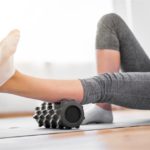Compression socks are like specially designed stockings that aim to boost blood flow and give support to your legs and feet. They work by applying a light, steady pressure on your lower limbs, which can help with different circulation problems and reduce swelling. Now, the big question for many is whether wearing these socks while you’re asleep is okay and helpful.
There isn’t clear evidence that wearing compression socks during sleep gives significant benefits for most healthy individuals. When lying down, gravity doesn’t affect circulation much, so compression might not be necessary. The primary benefit of the compression garment is helping the blood flow back to the heart against gravity when you’re upright.
However, some people dealing with leg swelling or certain medical conditions might benefit from wearing compression socks at night; on the flip side, some should avoid using compression socks during sleep.
If you want to wear compression socks to bed, there are some considerations you need to take.
Who May Benefit from Overnight Use
- People with leg ulcers
- Improving circulation to the affected areas – The compression helps push blood flow upwards and brings oxygen and nutrients to aid healing of the ulcer.
- Acting like a bandage to protect the wound – Compression stockings can keep dressings in place and prevent damage overnight.
- Preventing fluid buildup and swelling – Compression counters gravity and reduces edema around ulcers when lying down.
- People with restless legs syndrome (RLS)
- Improving blood circulation in the legs – The compression helps push blood flow upwards, which can reduce uncomfortable sensations
- Providing a gentle massaging effect – The pressure on the legs can help relax muscles and ease aches and discomfort
- Acting as a counter-stimulus – The compression gives sensory feedback that may reduce leg twitching and the urge to move.
- People with conditions affecting circulation
- Aiding blood flow – People with conditions affecting circulation, like varicose veins and venous insufficiency, can benefit from overnight use. Venous insufficiency and varicose veins may feel less symptomatic with the consistent pressure provided by compression socks. Your legs can benefit from improved circulation, potentially reducing edema and lymphedema.
- Providing compression therapy – If you have a history of blood clots or deep vein thrombosis (DVT), especially post-surgery, your healthcare provider might suggest compression therapy to reduce the risk of recurrence while you sleep.
Who Should Avoid Overnight Use
- People with peripheral arterial disease (PAD)
- Compression can further constrict already reduced blood flow in PAD patients, exacerbating symptoms like leg pain, cramps, and poor circulation.
- People with diabetes
- There is an increased risk of complications like blood clots or skin damage if the socks bunch up and create pressure points overnight. Diabetics already have a higher risk of foot wounds.
- People with sensory issues
- Those with sensory problems may fail to notice if the socks are too tight or become wrinkled overnight, which could interfere with circulation. The compression could cause tingling, numbness, or nerve pain, but these warning signs could go unnoticed.
Tips for Wearing Compression Socks to Bed
- Ensure proper fit. Socks that are too tight or bunch up can constrict circulation. Consider custom-fitted socks for maximum comfort.
- Select moisture-wicking, breathable materials like cotton, wool, or synthetic blends. This allows airflow and prevents overheating.
- Inspect skin daily for any irritation, wounds, or discomfort. Discontinue use if any develop.
- Remove socks periodically overnight to improve airflow and hygiene. Wearing 24/7 increases infection risk.
- Monitor for tingling, numbness, or nerve pain as signs to remove socks. Compression can impact nerves while sleeping.
- Wash socks in warm, soapy water and let them air dry. If you must machine wash, opt for a gentle cycle and consider using a mesh lingerie bag to protect the fabrics. Try not to use fabric softeners or bleach, as these can degrade the elastic fibers.
- Choose low compression (15 mmHg or less) for overnight wear. Higher compression can restrict blood flow when lying down. There are four different levels of compression, measured in millimeters of mercury (mmHg).
Mild compression (8-15 mmHg): Ideal for everyday wear to alleviate tired and aching legs.
Moderate compression (15-20 mmHg): Helps with travel, pregnancy, or mild swelling.
Firm compression (20-30 mmHg): Used for moderate to severe swelling, edema, and post-surgical recovery.
Extra firm compression (30-40 mmHg): Prescribed for severe venous issues or post-thrombotic syndrome.
The key is choosing light, properly fitted compression socks if worn at night while carefully monitoring skin and circulation to avoid complications.
The Bottom Line
So, can you sleep in compression socks? It depends. For those with leg ulcers, restless legs, or circulation issues, wearing them overnight might bring comfort, aiding healing and reducing discomfort. However, if you have arterial disease, diabetes, or sensory concerns, it’s a cautious road to tread, as the risks may outweigh the benefits.
The guide on wearing these socks to bed highlights the importance of a good fit, breathable materials, and regular checks for any issues. It’s not a one-size-fits-all situation, emphasizing the need for a personalized approach. If you’re considering wearing compression socks overnight, it’s better to consult with a healthcare provider first, as they can advise on whether it’s appropriate for your situation.



